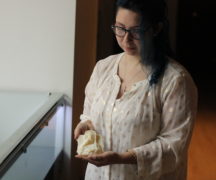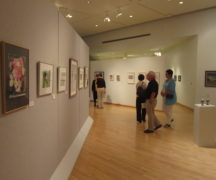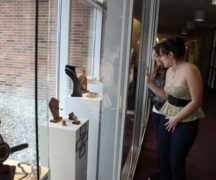By DAVID DUPONT
BG Independent News
Earlier this month before the BGSU School of Art unveiled “Wonder,” an exhibit featuring work of its next class of graduates, the school brought together a virtual panel of three professionals to ponder the question: “Where Next? The Future of Art”
Moderated by School Director Charles Kanwischer, the panel of Mark Zuzik, Adam Shirley and Wesley Taylor found themselves as much discussing the “where now” of living through the pandemic.
Shirley, a Detroit-based metalsmith, said in the past he always was able to get lost in his work. Yet during the pandemic he found it hard to “compartmentalize” his life, and achieve that same level of focus.
He attributed this to the mental toll of dealing with the pandemic. He did lose the work that he does for other artists and galleries, however, he did sell several large pieces. Shirley attributed this to patrons being stuck at home and staring at their walls, and deciding they wanted new art to look at.
Shirley no longer teaches, but he admires his colleagues who do and must adjust to remote learning.
That includes Taylor who teaches at Virginia Commonwealth University.
Much of the multimedia artist’s work had been digitally based. But he found after being on Zoom all day teaching, the fatigue set in. “My brain was rewired,” he said.
He turned to music. Taylor has been involved in the Detroit hip hop group, Athletic Mic League, for over 20 years, “so it’s not a major shift.”
“I’ve been writing and recording music because of the immediacy it lends to me personally,” he said.
Zuzik, a museum administrator, was working with the Pizzuti Collection in Columbus, which has now merged into the Columbus Museum of Art.
Zuzik took on a new role with the Columbus museum. The institution faced a problem: “How do we keep the museum afloat?” How does the museum “avoid doing something really terrible like laying off a ton of staff?”
Many of those people, he noted, are in already vulnerable groups.
So the museum, he said, created a number of online virtual programs.
They connected art with personal well-being, by launching a 30-minute-a-day mindfulness program. This was based on “slow looking,” which research has shown is beneficial.
The museum is planning on continuing with hybrid programs, Zuzik said.
This enables the museum to reach out to people who may not be comfortable in the museum setting, and to people who live too far away to come.
The racial justice protests in Columbus and across the nation have also pushed the museum to consider how it can reach underserved population, he said.
This involves everything from what the museum hangs on its walls to who it purchases goods and services from.
It means considering how accessible the facility is – how easily can people move around the space and how accessible the information about the art is.
“It’s really is something that’s being built into everything we do in a really conscious way.” And the museum can’t assume it is succeeding “until you really dig in and audit what you’re doing,” Zuzik said. “It’s work that never ends.”
Taylor said Richmond has been a focal point for protests because of its history as the capitol of the Confederacy and the presence of so many Confederate monuments. He and his colleagues decided that an annual outdoor art event should be presented throughout the city “really focusing to honor the movement happening over the summer.”
“We’re living in completely bizarre times,” Taylor said. While some people “have the privilege not to acknowledge” the toll of the pandemic, “with my Black friends the weight of COVID 19 is still very, very present. During the prolonged moment of quarantine and lock down, disparity and inequalities have doubled down and tripled down in many ways.”
This will affect people, including himself, in many unanticipated ways, he said.
Kanwischer asked them what they would tell students about how to navigate a career. He noted when he was in art school it was assumed students would become artists and teachers. “No one anticipated all the twists and turns your career can take.”
Zuzik talked about how he moved into arts administration. He took a part-time job as a gallery watcher. “They learned I could do other things.” He could research items in the collection, and write about it. He started doing an inventory, and “catalogued their catalogs.”
This led to positions of greater responsibility.
Taylor emphasized the importance of learning to write. Crafting an art history paper teaches students how to form an argument. “That can be one constant in all kinds of twists and turns,” he said.
Still, he admitted when he espouses that in his classes “I feel like Charlie Brown’s mom talking.”
Shirley noted that “while you’re busy planning your life, your life happens.”
He started off working for jewelers but after a decade or so he decided he wanted more from the work and shifted to creating sculptural objects.
Some of his students, he said, find work in the auto industry where their sculpting and fiber skills are valued.
Kanwischer said that in “the fluid society we inhabit” the creative problem solving and resilience that art students develop “will help them be successful.”
For Taylor the key is dedicating oneself to the creative endeavor and surrounding oneself with other creative people, and together finding pathways “to allow other people to be creative. … I feel totally blessed to be able to live my life in a way where I can make things and people can see those things and experience them.”





